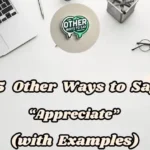“Hey!” is a frequent choice, yet your greeting might sometimes call for more warmth, genuine curiosity, or simply a more lasting impression. Encountering someone new, reconnecting with an old acquaintance, or sending a brief message all demand a fresh start.
This guide on Other Ways to Say “Hey” offers dynamic alternatives. Discover how to initiate conversations with renewed energy and an engaging tone.
What’s Another Way of Saying “Hey”?
- Hi there!
- What’s up?
- Yo, how’s it going?
- Hello, friend!
- Hey there!
- What’s good?
- Hiya!
- Yo, what’s up?
- Greetings!
- Howdy!
- What’s happening?
- Hey, good to see you!
- Hi, how’s it hanging?
- What’s new with you?
- Yo, good vibes!
1. “Hi There!”
“Hi There!” is a friendly, welcoming greeting that initiates conversation. It carries a warm, approachable tone that suits both personal and informal professional settings, such as meeting friends or greeting colleagues. This phrase conveys openness and enthusiasm for connecting, making it ideal for starting lighthearted interactions.
Example 1: You’re meeting a friend at a café. As you spot them, you wave and say, “Hi there!” They smile, wave back, and start chatting about their day.
Example 2: You’re texting a coworker to start a casual work discussion. You write, “Hi there!” They reply with a friendly message, ready to dive in.
2. “What’s Up?”
“What’s Up?” is a casual, inquiring greeting that invites an update on someone’s life or current state. It has a laid-back, friendly tone that encourages conversation, making it suitable for informal settings with friends or peers. This phrase conveys curiosity and openness to catching up.
Example 1: You run into a classmate on campus. You say, “What’s up?” They grin, share their latest project, and ask about yours.
Example 2: You’re texting a friend after a long week. You write, “What’s up?” They reply with an update about their weekend plans.
3. “Yo, How’s It Going?”
“Yo, How’s It Going?” combines a trendy, informal greeting with a question about well-being. It carries a playful, informal tone that’s perfect for close friends or casual encounters, conveying a sense of familiarity and enthusiasm for reconnecting.
Example 1: You’re meeting your best friend at a park. You shout, “Yo, how’s it going?” They laugh, high-five you, and start talking about their day.
Example 2: You’re texting a buddy to check in. You write, “Yo, how’s it going?” They reply with a funny story from their week.
4. “Hello, Friend!”
“Hello, Friend!” is a warm, personal greeting that emphasizes a special connection. It has a friendly, affectionate tone that suits close relationships or moments of camaraderie, conveying warmth and a sense of belonging.
Example 1: You’re visiting a close friend at their home. As they open the door, you say, “Hello, friend!” They hug you, excited, and invite you in.
Example 2: You’re texting a childhood friend to catch up. You write, “Hello, friend!” They reply with a warm message, eager to reconnect.
5. “Hey There!”
“Hey There!” is a friendly, slightly softer greeting. It carries a warm, approachable tone that works in both personal and informal professional settings, such as greeting neighbors or colleagues. This phrase conveys enthusiasm and openness to conversation.
Example 1: You’re waving to a neighbor across the street. You call out, “Hey there!” They wave back, smile, and start a quick chat.
Example 2: You’re texting a coworker to start a casual conversation. You write, “Hey there!” They reply, ready to discuss a project.
Related Post: 15 Other Ways to Say Hello (With Examples)
6. “What’s Good?”
“What’s Good?” is a trendy, casual greeting that asks for positive updates or exciting news. It has a relaxed, upbeat tone that suits informal settings with friends or peers, conveying curiosity and a laid-back vibe for starting conversations.
Example 1: You’re meeting friends at a local hangout spot. You say, “What’s good?” They laugh, share their recent adventures, and ask about yours.
Example 2: You’re texting a group chat to plan a night out. You write, “What’s good?” Friends reply with ideas, excited to plan.
7. “Hiya!”
“Hiya!” is a cheerful, energetic greeting. It carries a playful, friendly tone that conveys enthusiasm, making it ideal for informal settings with friends or acquaintances. This phrase creates an instant sense of warmth and excitement.
Example 1: You’re greeting a group of friends at a picnic. You wave and say, “Hiya!” They cheer, wave back, and invite you to join the fun.
Example 2: You’re texting a friend to start a fun conversation. You write, “Hiya!” They reply with a happy emoji, ready to chat.
8. “Yo, What’s Up?”
“Yo, What’s Up?” is a bold, casual greeting that directly invites an update. It has a cool, informal tone that suits close friends or casual encounters, conveying familiarity and enthusiasm for catching up. This phrase is direct and energetic.
Example 1: You’re spotting a friend at a concert. You shout, “Yo, what’s up?” They grin, high-five you, and start talking about the show.
Example 2: You’re texting a buddy to check in after a trip. You write, “Yo, what’s up?” They reply with photos and stories from their journey.
9. “Greetings!”
“Greetings!” is a formal yet friendly salutation. It carries a warm, slightly formal tone that suits professional or semi-formal settings, such as meeting new people or starting emails. This phrase conveys respect and openness to conversation.
Example 1: You’re meeting a new colleague at a work event. You smile and say, “Greetings!” They nod, introduce themselves, and start chatting.
Example 2: You’re emailing a group of clients to start a discussion. You write, “Greetings!” They reply, appreciating the professional tone.
10. “Howdy!”
“Howdy!” is a folksy, friendly greeting with a touch of charm. It has a warm, informal tone that evokes a sense of friendliness and simplicity, making it suitable for casual settings or lighthearted encounters. This phrase conveys a welcoming, down-to-earth vibe.
Example 1: You’re visiting a friend in a small town. You wave and say, “Howdy!” They laugh, greet you back, and invite you for coffee.
Example 2: You’re texting a friend to start a fun chat. You write, “Howdy!” They reply with a cowboy emoji, keeping the playful mood.
Related Post: 15 Other Ways to Say “Greetings” (With Examples)
11. “What’s Happening?”
“What’s Happening?” is a casual, curious greeting that invites an update on current events or activities. It has a friendly, laid-back tone that encourages conversation, making it suitable for informal settings with friends or peers. This phrase conveys interest in the other person’s current state.
Example 1: You’re meeting a coworker at a café for a break. You say, “What’s happening?” They smile, share work updates, and ask about you.
Example 2: You’re texting a friend to catch up. You write, “What’s happening?” They reply with details about their recent activities.
12. “Hey, Good to See You!”
“Hey, Good to See You!” combines a greeting with an expression of genuine joy. It has an enthusiastic, personal tone that emphasizes excitement about reconnecting, making it ideal for friends or familiar faces in casual settings. This phrase conveys warmth and happiness at the sight of the other person.
Example 1: You’re running into an old friend at a market. You say, “Hey, good to see you!” They hug you, thrilled, and start catching up immediately.
Example 2: You’re texting a friend you haven’t seen in a while. You write, “Hey, good to see you!” They reply, excited to plan a meetup soon.
13. “Hi, How’s It Hanging?”
“Hi, How’s It Hanging?” is a playful, informal greeting that asks about someone’s general well-being. It has a fun, relaxed tone that suits close friends or casual encounters, conveying a lighthearted vibe for starting conversations.
Example 1: You’re meeting a buddy at a skate park. You say, “Hi, how’s it hanging?” They laugh, fist-bump you, and share their latest tricks.
Example 2: You’re texting a friend to start a casual chat. You write, “Hi, how’s it hanging?” They reply with a funny update, keeping the mood light.
14. “What’s New With You?”
“What’s New With You?” is a curious greeting that specifically invites updates on recent events in someone’s life. It has a warm, engaging tone that encourages detailed conversation, making it suitable for personal settings where you want to genuinely catch up. This phrase conveys genuine interest in the other person’s life.
Example 1: You’re meeting a friend for lunch. You say, “What’s new with you?” They smile, share their recent job change, and ask about you.
Example 2: You’re texting a cousin you haven’t talked to in a while. You write, “What’s new with you?” They reply with family updates, excited to chat.
15. “Yo, Good Vibes!”
“Yo, Good Vibes!” is a trendy, positive greeting that immediately sets a cheerful and optimistic tone. It has a cool, enthusiastic vibe that conveys optimism and a desire for positive interaction, making it ideal for casual settings or social media interactions with friends. This phrase creates a fun, energetic start to a conversation.
Example 1: You’re joining friends at a beach party. You shout, “Yo, good vibes!” They cheer, high-five you, and invite you to dance.
Example 2: You’re texting a group chat to start a fun conversation. You write, “Yo, good vibes!” Friends reply with excited emojis, ready to chat.
Conclusion
“Hey!” often feels insufficient for truly engaging a conversation. The preceding discussion on other ways to say “Hey” has equipped you with a diverse set of greetings, allowing you to initiate interactions with greater warmth, curiosity, or impact.
Don’t let your opening fall flat. Instead, make every initial connection memorable and meaningful. To further refine all your daily communications, delve into the extensive resources on the Other Ways To Say homepage.

Thomas Schneider is a language enthusiast and expert in synonyms, dedicated to exploring the beauty of words and their nuanced meanings. With a passion for linguistics and clear communication, Thomas helps readers enrich their vocabulary and understand the subtle art of word choice. Whether you’re a writer, student, or language lover, his insights offer practical tools to elevate your language skills.


